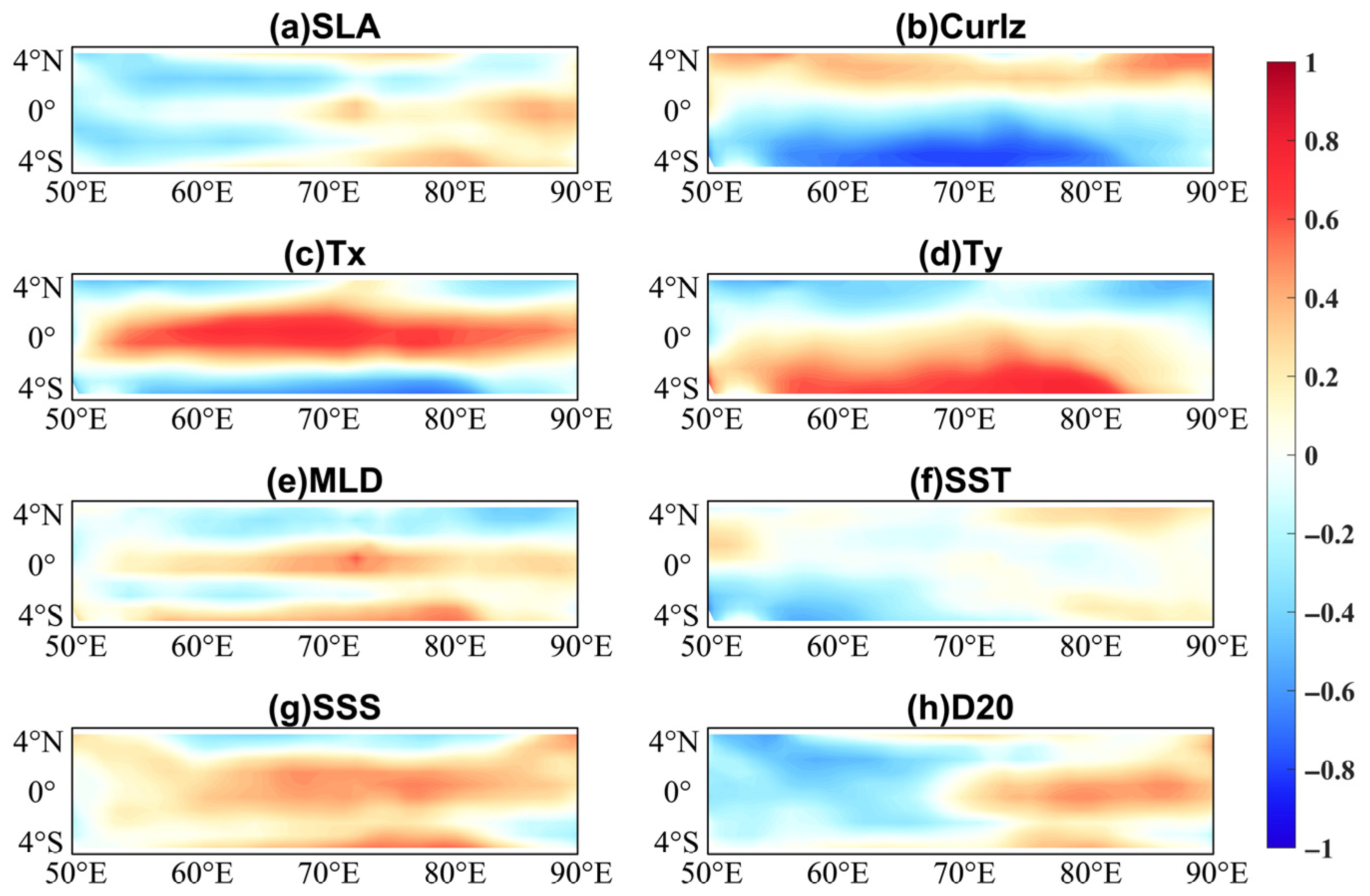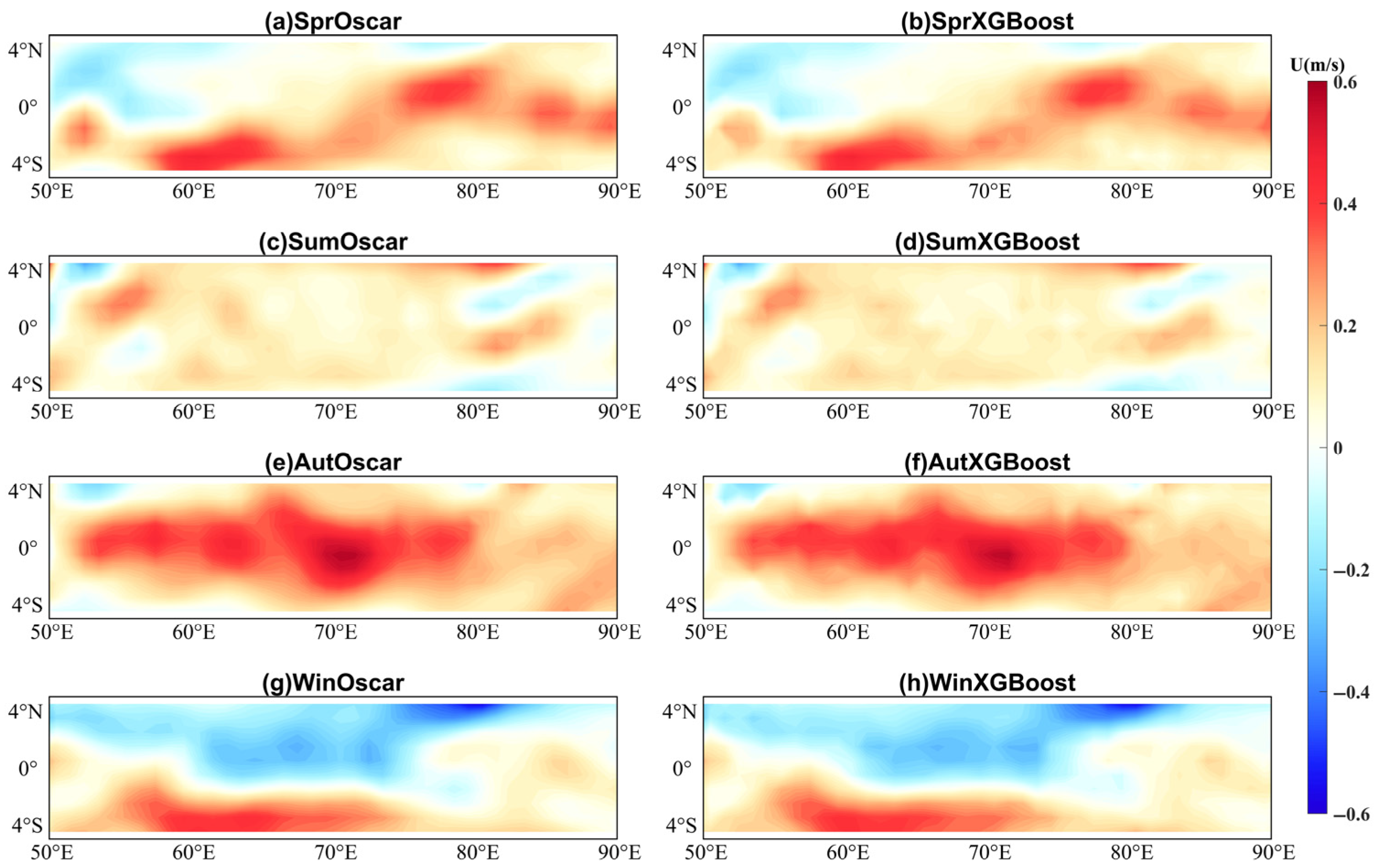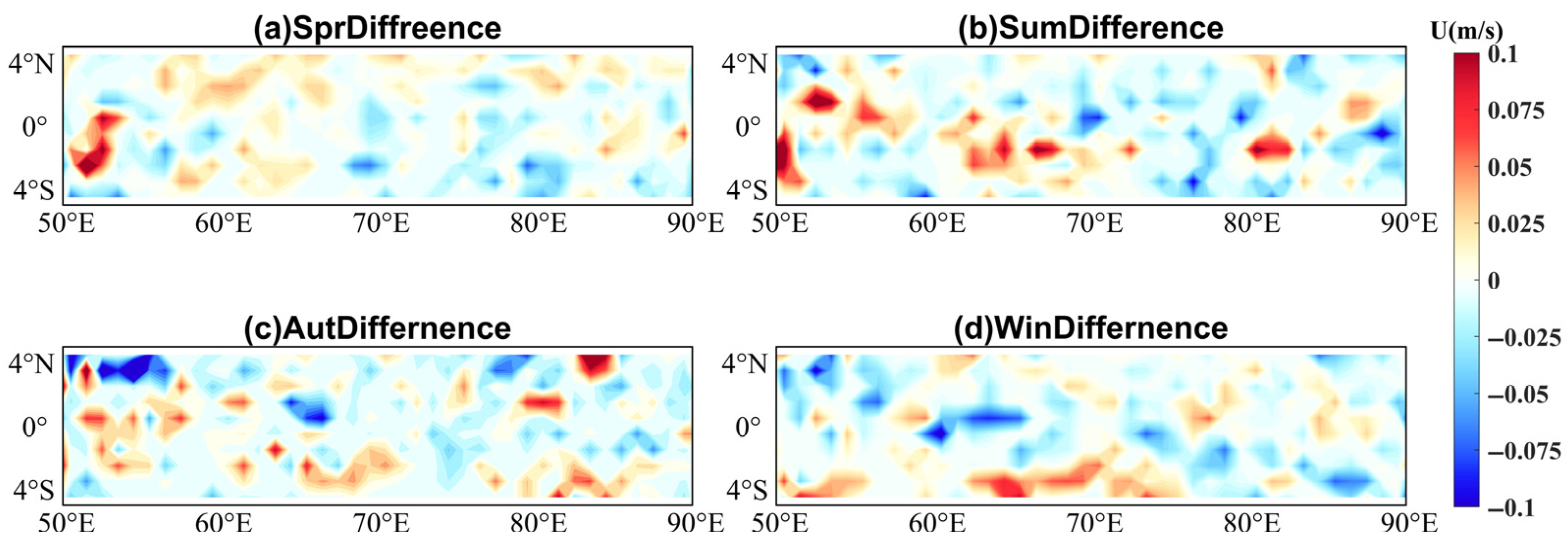Machine Learning Reconstruction of Wyrtki Jet Seasonal Variability in the Equatorial Indian Ocean
Abstract
1. Introduction
- Machine learning algorithms (e.g., Extreme Gradient Boosting (XGBoost)) can capture complex nonlinear relationships between sea surface parameters (e.g., SST, SSS, sea level anomaly (SLA)) and WJ velocity, overcoming limitations inherent to conventional linear regression approaches.
- Through the integration of satellite-derived parameters (e.g., wind stress components (Tx and Ty); wind stress curl (Curlz)) and geographical information (longitude, latitude), ML models can comprehensively characterize the spatial distribution patterns of WJ.
- Compared with numerical models, trained ML algorithms enable rapid reconstruction with significantly reduced computational costs.
2. Data and Methods
2.1. Data
2.2. Methods
3. Results
3.1. Correlation Analysis Between U and Sea Surface Parameters
3.2. Identification of Input Variables
3.3. Evaluation of the XGBoost Model
4. Discussion
5. Conclusions
Author Contributions
Funding
Data Availability Statement
Acknowledgments
Conflicts of Interest
Appendix A
Appendix A.1. Validation of OSCAR Reanalysis Data Against RAMA Mooring Observations

Appendix A.2. XGBoost-Based Reconstruction Framework for Wyrtki Jet Zonal Currents

Appendix A.3. Correlation Analysis of Marine Parameters with U

Appendix A.4. Feature Importance Analysis of Marine Parameters in WJ Reconstruction

References
- Wyrtki, K. An Equatorial Jet in the Indian Ocean. Science 1973, 181, 262–264. [Google Scholar] [CrossRef] [PubMed]
- Haiming, X. Seasonal variability of the west-east water mass exchange on the section of central equatorial Indian Ocean and its regional difference. Acta Oceanol. Sin. 2012, 30, 1082–1092. [Google Scholar] [CrossRef]
- Sun, Q.; Zhang, Y.; Du, Y.; Jiang, X. Asymmetric Response of Sea Surface Salinity to Extreme Positive and Negative Indian Ocean Dipole in the Southern Tropical Indian Ocean. J. Geophys. Res.-Ocean. 2022, 127, e2022JC018986. [Google Scholar] [CrossRef]
- Murtugudde, R.; Busalacchi, A.J. Interannual Variability of the Dynamics and Thermodynamics of the Tropical Indian Ocean. J. Clim. 1999, 12, 2300–2326. [Google Scholar] [CrossRef]
- Vinayachandran, P.N.; Saji, N.H.; Yamagata, T. Response of the equatorial Indian Ocean to an unusual wind event during 1994. Geophys. Res. Lett. 1999, 26, 1613–1616. [Google Scholar] [CrossRef]
- Chatterjee, A.; Shankar, D.; McCreary, J.P.; Vinayachandran, P.N.; Mukherjee, A. Dynamics of Andaman Sea circulation and its role in connecting the equatorial Indian Ocean to the Bay of Bengal. J. Geophys. Res. Ocean. 2017, 122, 3200–3218. [Google Scholar] [CrossRef]
- Molinari, R.L.; Olson, D.; Reverdin, G. Surface current distributions in the tropical Indian Ocean derived from compilations of surface buoy trajectories. J. Geophys. Res. Ocean. 1990, 95, 7217–7238. [Google Scholar] [CrossRef]
- Qiu, Y.; Li, L.; Yu, W. Behavior of the Wyrtki Jet observed with surface drifting buoys and satellite altimeter. Geophys. Res. Lett. 2009, 36, 120–131. [Google Scholar] [CrossRef]
- Duan, Y.; Liu, L.; Han, G.; Liu, H.; Yu, W.; Yang, G.; Wang, H.; Wang, H.; Liu, Y.; Zahid; et al. Anomalous behaviors of Wyrtki Jets in the equatorial Indian Ocean during 2013. Sci. Rep. 2016, 6, 29688. [Google Scholar] [CrossRef]
- Joseph, S.; Wallcraft, A.J.; Jensen, T.G.; Ravichandran, M.; Shenoi, S.S.C.; Nayak, S. Weakening of spring Wyrtki jets in the Indian Ocean during 2006–2011. J. Geophys. Res.-Ocean. 2012, 117, C04012. [Google Scholar] [CrossRef]
- Reppin, J.R.; Schott, F.A.; Fischer, J.; Quadfasel, D. Equatorial currents and transports in the upper central Indian Ocean: Annual cycle and interannual variability. J. Geophys. Res.-Ocean. 1999, 104, 15495–15514. [Google Scholar] [CrossRef]
- Chen, G.; Han, W.; Li, Y.; Wang, D.; McPhaden, M.J. Seasonal-to-Interannual Time-Scale Dynamics of the Equatorial Undercurrent in the Indian Ocean. J. Phys. Oceanogr. 2015, 45, 1532–1553. [Google Scholar] [CrossRef]
- Deng, K.; Cheng, X.; Feng, T.; Ma, T.; Duan, W.; Chen, J. Interannual variability of the spring Wyrtki Jet. J. Oceanol. Limnol. 2021, 39, 26–44. [Google Scholar] [CrossRef]
- Schott, F.A.; McCreary, J.P. The monsoon circulation of the Indian Ocean. Prog. Oceanogr. 2001, 51, 1–123. [Google Scholar] [CrossRef]
- Rao, R.R.; Molinari, R.L.; Festa, J.F. Evolution of the climatological near-surface thermal structure of the tropical Indian Ocean: 1. Description of mean monthly mixed layer depth, and sea surface temperature, surface current, and surface meteorological fields. J. Geophys. Res. Ocean. 1989, 94, 10801–10815. [Google Scholar] [CrossRef]
- Masumoto, Y.; Hase, H.; Kuroda, Y.; Matsuura, H.; Takeuchi, K. Intraseasonal variability in the upper layer currents observed in the eastern equatorial Indian Ocean. Geophys. Res. Lett. 2005, 32, L02607. [Google Scholar] [CrossRef]
- McPhaden, M.J.; Meyers, G.; Ando, K.; Masumoto, Y.; Murty, V.S.N.; Ravichandran, M.; Syamsudin, F.; Vialard, J.; Yu, L.; Yu, W. RAMA: The Research Moored Array for African–Asian–Australian Monsoon Analysis and Prediction. Bull. Am. Meteorol. Soc. 2009, 90, 459–480. [Google Scholar] [CrossRef]
- Zhang, J.; Liu, B.; Ren, S.; Han, W.; Ding, Y.; Peng, S. A 4 km daily gridded meteorological dataset for China from 2000 to 2020. Sci. Data 2024, 11, 1230. [Google Scholar] [CrossRef]
- Mak, H.W.L.; Laughner, J.L.; Fung, J.C.H.; Zhu, Q.; Cohen, R.C. Improved Satellite Retrieval of Tropospheric NO2 Column Density via Updating of Air Mass Factor (AMF): Case Study of Southern China. Remote Sens. 2018, 10, 1789. [Google Scholar] [CrossRef]
- Noone, S.; Atkinson, C.; Berry, D.I.; Dunn, R.J.H.; Freeman, E.; Perez Gonzalez, I.; Kennedy, J.J.; Kent, E.C.; Kettle, A.; McNeill, S.; et al. Progress towards a holistic land and marine surface meteorological database and a call for additional contributions. Geosci. Data J. 2021, 8, 103–120. [Google Scholar] [CrossRef]
- Perez, J.d.J.S.; Garza, A.G.J.; Monreal, D.S. Dataset on meteorological forcing mechanisms impacting marine circulation and oceanographic variables in the northern part of the Veracruz reef system. Data Brief 2023, 51, 109637. [Google Scholar] [CrossRef] [PubMed]
- Wu, L.C.; Doong, D.J.; Lai, J.W. Sea Surface Current Estimation from a Semi-Enclosed Bay Using Coastal X-Band Radar Images. IEEE Trans. Geosci. Remote Sens. 2024, 62, 1–11. [Google Scholar] [CrossRef]
- Zhu, Z.; Geng, X.; Li, S.; Xie, T.; Yan, X.-H. Ocean surface current retrieval at Hangzhou Bay from Himawari-8 sequential satellite images. Sci. China Earth Sci. 2020, 63, 1026–1038. [Google Scholar] [CrossRef]
- Fablet, R.; Febvre, Q.; Chapron, B. Multimodal 4DVarNets for the Reconstruction of Sea Surface Dynamics From SST-SSH Synergies. IEEE Trans. Geosci. Remote Sens. 2023, 61, 1–14. [Google Scholar] [CrossRef]
- Yang, X.; Chong, J.; Zhao, Y. Sea Surface Current Retrieval From Sequential SAR and Ocean Color Images for Eddy Kinematics Analysis: A Case Study in the Northern Tyrrhenian Sea. IEEE J. Sel. Top. Appl. Earth Obs. Remote Sens. 2024, 17, 10126–10136. [Google Scholar] [CrossRef]
- Sun, W.; Jia, C.; Fan, C.; Li, W.; Dai, Y.; Huang, W. Maximum a Posteriori Based Ocean Surface Current Inversion for Doppler Scatterometer. IEEE J. Sel. Top. Appl. Earth Obs. Remote Sens. 2024, 17, 2067–2076. [Google Scholar] [CrossRef]
- Sun, J.; Li, H.; Lin, W.; He, Y. Joint Inversion of Sea Surface Wind and Current Velocity Based on Sentinel-1 Synthetic Aperture Radar Observations. J. Mar. Sci. Eng. 2024, 12, 450. [Google Scholar] [CrossRef]
- Ciani, D.; Rio, M.-H.; Menna, M.; Santoleri, R. A Synergetic Approach for the Space-Based Sea Surface Currents Retrieval in the Mediterranean Sea. Remote Sens. 2019, 11, 1285. [Google Scholar] [CrossRef]
- Bao, Q.; Lin, M.; Zhang, Y.; Dong, X.; Lang, S.; Gong, P. Ocean Surface Current Inversion Method for a Doppler Scatterometer. IEEE Trans. Geosci. Remote Sens. 2017, 55, 6505–6516. [Google Scholar] [CrossRef]
- Wang, W.; Zhou, H.; Zheng, S.; Lü, G.; Zhou, L. Ocean surface currents estimated from satellite remote sensing data based on a global hexagonal grid. Int. J. Digit. Earth 2023, 16, 1073–1093. [Google Scholar] [CrossRef]
- Su, H.; Wu, X.; Yan, X.-H.; Kidwell, A. Estimation of subsurface temperature anomaly in the Indian Ocean during recent global surface warming hiatus from satellite measurements: A support vector machine approach. Remote Sens. Environ. 2015, 160, 63–71. [Google Scholar] [CrossRef]
- Su, H.; Huang, L.; Li, W.; Yang, X.; Yan, X.H. Retrieving Ocean Subsurface Temperature Using a Satellite-Based Geographically Weighted Regression Model. J. Geophys. Res. Ocean. 2018, 123, 5180–5193. [Google Scholar] [CrossRef]
- Zhang, S.Y.; Yang, Y.Z.; Xie, K.W.; Gao, J.H.; Zhang, Z.Y.; Niu, Q.R.; Wang, G.J.; Che, Z.H.; Mu, L.; Jia, S. Spatial-Temporal Siamese Convolutional Neural Network for Subsurface Temperature Reconstruction. IEEE Trans. Geosci. Remote Sens. 2024, 62, 1–16. [Google Scholar] [CrossRef]
- Leupold, M.; Pfeiffer, M.; Watanabe, T.K.; Reuning, L.; Garbe-Schönberg, D.; Shen, C.C.; Brummer, G.J.A. El Nino-Southern Oscillation and internal sea surface temperature variability in the tropical Indian Ocean since 1675. Clim. Past 2021, 17, 151–170. [Google Scholar] [CrossRef]
- Nairn, M.G.; Lear, C.H.; Sosdian, S.M.; Bailey, T.R.; Beavington-Penney, S. Tropical Sea Surface Temperatures Following the Middle Miocene Climate Transition From Laser-Ablation ICP-MS Analysis of Glassy Foraminifera. Paleoceanogr. Paleoclimatol. 2021, 36, e2020PA004165. [Google Scholar] [CrossRef]
- Burdanowitz, N.; Rixen, T.; Gaye, B.; Emeis, K.C. Signals of Holocene climate transition amplified by anthropogenic land-use changes in the westerly-Indian monsoon realm. Clim. Past 2021, 17, 1735–1749. [Google Scholar] [CrossRef]
- Ding, X.; Bassinot, F.; Pang, X.L.; Kou, Y.X.; Zhou, L.P. Heat Transport Processes of the Indonesian Throughflow Along the Outflow Pathway in the Eastern Indian Ocean During the Last 160 Kyr. Paleoceanogr. Paleoclimatol. 2023, 38, e2023PA004620. [Google Scholar] [CrossRef]
- Shi, X.F.; Liu, S.F.; Zhang, X.; Sun, Y.C.; Cao, P.; Zhang, H.; Li, X.Y.; Xu, S.; Qiao, S.Q.; Khokiattiwong, S.; et al. Millennial-scale hydroclimate changes in Indian monsoon realm during the last deglaciation. Quat. Sci. Rev. 2022, 292, 107702. [Google Scholar] [CrossRef]
- Tiger, B.H.; Burns, S.; Dawson, R.R.; Scroxton, N.; Godfrey, L.R.; Ranivoharimanana, L.; Faina, P.; McGee, D. Zonal Indian Ocean Variability Drives Millennial-Scale Precipitation Changes in Northern Madagascar. Paleoceanogr. Paleoclimatol. 2023, 38, e2023PA004626. [Google Scholar] [CrossRef]
- Gong, Z.; He, H.; Fan, D.; Zeng, Y.; Liu, Z.; Pan, B. Comparison of Machine Learning Inversion Methods for Salinity in the Central Indian Ocean Based on SMOS Satellite Data. Can. J. Remote Sens. 2024, 50, 2298575. [Google Scholar] [CrossRef]
- Qi, J.; Sun, G.; Xie, B.; Li, D.; Yin, B. Deep learning to estimate ocean subsurface salinity structure in the Indian Ocean using satellite observations. J. Oceanol. Limnol. 2024, 42, 377–389. [Google Scholar] [CrossRef]
- Qi, J.; Xie, B.; Li, D.; Chi, J.; Yin, B.; Sun, G. Estimating thermohaline structures in the tropical Indian Ocean from surface parameters using an improved CNN model. Front. Mar. Sci. 2023, 10, 101181182. [Google Scholar] [CrossRef]
- Kumar, P.; Hamlington, B.; Cheon, S.H.; Han, W.Q.; Thompson, P. 20th Century Multivariate Indian Ocean Regional Sea Level Reconstruction. J. Geophys. Res.-Ocean. 2020, 125, e2020JC016270. [Google Scholar] [CrossRef]
- Huang, S.; Shao, J.; Chen, Y.J.; Qi, J.; Wu, S.S.; Zhang, F.; He, X.Q.; Du, Z.H. Reconstruction of dissolved oxygen in the Indian Ocean from 1980 to 2019 based on machine learning techniques. Front. Mar. Sci. 2023, 10, 1291232. [Google Scholar] [CrossRef]
- Heidrich, K.N.; Meeuwig, J.J.; Zeller, D. Reconstructing past fisheries catches for large pelagic species in the Indian Ocean. Front. Mar. Sci. 2023, 10, 1177872. [Google Scholar] [CrossRef]
- Zeller, D.; Ansell, M.; Andreoli, V.; Heidrich, K. Trends in Indian Ocean marine fisheries since 1950: Synthesis of reconstructed catch and effort data. Mar. Freshw. Res. 2023, 74, 301–319. [Google Scholar] [CrossRef]
- Martinez, E.; Gorgues, T.; Lengaigne, M.; Fontana, C.; Sauzède, R.; Menkes, C.; Uitz, J.; Di Lorenzo, E.; Fablet, R. Reconstructing Global Chlorophyll-a Variations Using a Non-linear Statistical Approach. Front. Mar. Sci. 2020, 7, 00464. [Google Scholar] [CrossRef]
- Imai, R.; Sato, T.; Chiyonobu, S.; Iryu, Y. Reconstruction of Miocene to Pleistocene sea-surface conditions in the eastern Indian Ocean on the basis of calcareous nannofossil assemblages from ODP Hole 757B. Isl. Arc. 2020, 29, e12373. [Google Scholar] [CrossRef]
- Tangunan, D.; Berke, M.A.; Cartagena-Sierra, A.; Flores, J.A.; Gruetzner, J.; Jiménez-Espejo, F.; LeVay, L.J.; Baumann, K.H.; Romero, O.; Saavedra-Pellitero, M.; et al. Strong glacial-interglacial variability in upper ocean hydrodynamics, biogeochemistry, and productivity in the southern Indian Ocean. Commun. Earth Environ. 2021, 2, 001480. [Google Scholar] [CrossRef]
- Chen, Z.Q.; Wang, X.D.; Liu, L.; Wang, X.T. Estimating Three-Dimensional Structures of Eddy in the South Indian Ocean From the Satellite Observations Based on the isQG Method. Earth Space Sci. 2023, 10, e2023EA002991. [Google Scholar] [CrossRef]
- Dhyani, R.; Bhattacharyya, A.; Rawal, R.S.; Joshi, R.; Shekhar, M.; Ranhotra, P.S. Is tree ring chronology of blue pine (Pinus wallichiana A. B. Jackson) prospective for summer drought reconstruction in the Western Himalaya? J. Asian Earth Sci. 2022, 229, 105142. [Google Scholar] [CrossRef]
- Yang, G.G.; Wang, Q.S.; Feng, J.C.; He, L.C.; Li, R.Z.; Lu, W.F.; Liao, E.H.; Lai, Z.G. Can three-dimensional nitrate structure be reconstructed from surface information with artificial intelligence?—A proof-of-concept study. Sci. Total Environ. 2024, 924, 171365. [Google Scholar] [CrossRef] [PubMed]
- Saraswat, R.; Singh, D.P.; Lea, D.W.; Mackensen, A.; Naik, D.K. Indonesian throughflow controlled the westward extent of the Indo-Pacific Warm Pool during glacial-interglacial intervals. Glob. Planet. Change 2019, 183, 1161–1175. [Google Scholar] [CrossRef]
- Rubbelke, C.B.; Bhattacharya, T.; Feng, R.; Burls, N.J.; Knapp, S.; McClymont, E.L. Plio-Pleistocene Southwest African Hydroclimate Modulated by Benguela and Indian Ocean Temperatures. Geophys. Res. Lett. 2023, 50, e2023GL103003. [Google Scholar] [CrossRef]
- Gu, C.; Qi, J.; Zhao, Y.; Yin, W.; Zhu, S. Estimation of the Mixed Layer Depth in the Indian Ocean from Surface Parameters: A Clustering-Neural Network Method. Sensors 2022, 22, 5600. [Google Scholar] [CrossRef]
- Zhao, Y.; Qi, J.; Zhu, S.; Jia, W.; Gong, X.; Yin, W.; Yin, B. Estimation of the barrier layer thickness in the Indian Ocean based on hybrid neural network model. Deep Sea Res. Part I Oceanogr. Res. Pap. 2023, 202, 104179. [Google Scholar] [CrossRef]
- Pujol, M.I.; Faugère, Y.; Taburet, G.; Dupuy, S.; Pelloquin, C.; Ablain, M.; Picot, N. DUACS DT2014: The new multi-mission altimeter data set reprocessed over 20 years. Ocean Sci. 2016, 12, 1067–1090. [Google Scholar] [CrossRef]
- Le Traon, P.Y.; Nadal, F.; Ducet, N. An Improved Mapping Method of Multisatellite Altimeter Data. J. Atmos. Ocean. Technol. 1998, 15, 522–534. [Google Scholar] [CrossRef]
- Soci, C.; Hersbach, H.; Simmons, A.; Poli, P.; Bell, B.; Berrisford, P.; Horanyi, A.; Munoz-Sabater, J.; Nicolas, J.; Radu, R.; et al. The ERA5 global reanalysis from 1940 to 2022. Q. J. R. Meteorol. Soc. 2024, 150, 4014–4048. [Google Scholar] [CrossRef]
- Bonjean, F.; Lagerloef, G.S.E. Diagnostic Model and Analysis of the Surface Currents in the Tropical Pacific Ocean. J. Phys. Oceanogr. 2002, 32, 2938–2954. [Google Scholar] [CrossRef]
- Zuo, H.; Balmaseda, M.A.; Tietsche, S.; Mogensen, K.; Mayer, M. The ECMWF operational ensemble reanalysis-analysis system for ocean and sea ice: A description of the system and assessment. Ocean Sci. 2019, 15, 779–808. [Google Scholar] [CrossRef]
- Chen, T.; Guestrin, C. XGBoost: A Scalable Tree Boosting System. In Proceedings of the 22nd ACM SIGKDD International Conference on Knowledge Discovery and Data Mining, San Francisco, CA, USA, 13–17 August 2016; pp. 785–794. [Google Scholar]
- Girach, I.A.; Ponmalar, M.; Murugan, S.; Rahman, P.A.; Babu, S.S.; Ramachandran, R. Applicability of Machine Learning Model to Simulate Atmospheric CO2 Variability. IEEE Trans. Geosci. Remote Sens. 2022, 60, 1–6. [Google Scholar] [CrossRef]
- Miao, J.; Zhen, J.; Wang, J.; Zhao, D.; Jiang, X.; Shen, Z.; Gao, C.; Wu, G. Mapping Seasonal Leaf Nutrients of Mangrove with Sentinel-2 Images and XGBoost Method. Remote Sens. 2022, 14, 3679. [Google Scholar] [CrossRef]
- Samat, A.; Li, E.; Wang, W.; Liu, S.; Lin, C.; Abuduwaili, J. Meta-XGBoost for Hyperspectral Image Classification Using Extended MSER-Guided Morphological Profiles. Remote Sens. 2020, 12, 1973. [Google Scholar] [CrossRef]
- Trenberth, K.E. The Mean Annual Cycle in Global Ocean Wind Stress. J. Phys. Oceanogr. 1990, 20, 1742–1760. [Google Scholar] [CrossRef]












| Index | Input Variable | Data Source | Ouput Variable | Data Source | Time Range | Time/Spatial Resolution |
|---|---|---|---|---|---|---|
| Data | Tx | ERA5 | U | OSCAR | 1993–2022 | Monthly 1° × 1° |
| Ty | ||||||
| Curlz | ||||||
| D20 | ORAS5 | |||||
| SSS | ||||||
| SST | ||||||
| MLD | ||||||
| SLA | AVISO |
| Variables | Tx | Ty | SSS | MLD | D20 | SLA | Curlz | SST | LON | LAT |
|---|---|---|---|---|---|---|---|---|---|---|
| Case 1 | √ | √ | ||||||||
| Case 2 | √ | √ | √ | |||||||
| Case 3 | √ | √ | √ | √ | ||||||
| Case 4 | √ | √ | √ | √ | √ | |||||
| Case 5 | √ | √ | √ | √ | √ | √ | ||||
| Case 6 | √ | √ | √ | √ | √ | √ | √ | |||
| Case 7 | √ | √ | √ | √ | √ | √ | √ | √ | ||
| Case 8 | √ | √ | √ | √ | √ | √ | √ | √ | √ | |
| Case 9 | √ | √ | √ | √ | √ | √ | √ | √ | √ | √ |
Disclaimer/Publisher’s Note: The statements, opinions and data contained in all publications are solely those of the individual author(s) and contributor(s) and not of MDPI and/or the editor(s). MDPI and/or the editor(s) disclaim responsibility for any injury to people or property resulting from any ideas, methods, instructions or products referred to in the content. |
© 2025 by the authors. Licensee MDPI, Basel, Switzerland. This article is an open access article distributed under the terms and conditions of the Creative Commons Attribution (CC BY) license (https://creativecommons.org/licenses/by/4.0/).
Share and Cite
Li, D.; Zheng, S.; Zheng, C.; Xie, L.; Yan, L. Machine Learning Reconstruction of Wyrtki Jet Seasonal Variability in the Equatorial Indian Ocean. Algorithms 2025, 18, 431. https://doi.org/10.3390/a18070431
Li D, Zheng S, Zheng C, Xie L, Yan L. Machine Learning Reconstruction of Wyrtki Jet Seasonal Variability in the Equatorial Indian Ocean. Algorithms. 2025; 18(7):431. https://doi.org/10.3390/a18070431
Chicago/Turabian StyleLi, Dandan, Shaojun Zheng, Chenyu Zheng, Lingling Xie, and Li Yan. 2025. "Machine Learning Reconstruction of Wyrtki Jet Seasonal Variability in the Equatorial Indian Ocean" Algorithms 18, no. 7: 431. https://doi.org/10.3390/a18070431
APA StyleLi, D., Zheng, S., Zheng, C., Xie, L., & Yan, L. (2025). Machine Learning Reconstruction of Wyrtki Jet Seasonal Variability in the Equatorial Indian Ocean. Algorithms, 18(7), 431. https://doi.org/10.3390/a18070431






